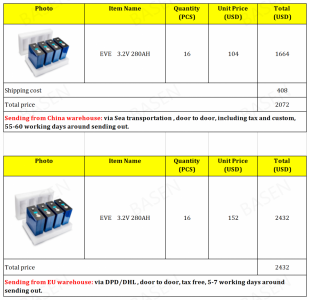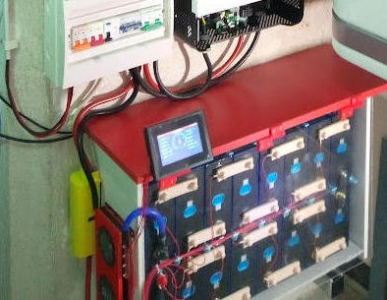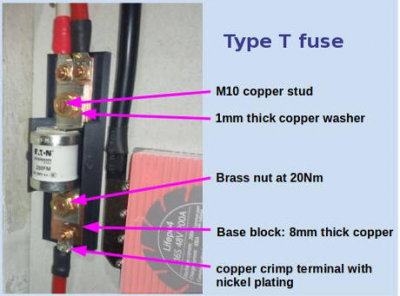As a note to anyone interested in building a battery. I've been exploring the costs for cells. Below is the cost for 16 x 280ah cells at 3.2v. This works out at 14.3kW of storage. The quote has two factors, shipped to the UK from China (delivered and customs cleared 55-60 days) and for cells in the UK (available from May). The costs are;
- China - $2,072 (USD) - £1,575 - £0.11/wh
- UK - $2,422 (USD) - £1,841 - £0.13/wh
You would also need a case, and that's around £500 delivered to the UK. So 14kwh of storage for £2000 or £2300 (depending on where the cells come from)
If others are considering building a battery out of the raw LiFePO4 cells, then there will need to be a lot more technical discussion here on this topic.
As a bare minimum you should expect to spend a further £200 in addition to the BMS for safety fuse/trips, hefty cable and copper crimps.
Beware also that I have needed to design a few bits and create them on my 3D printer. Eg It's almost impossible to find the fuse base/holder for the type of fuse with adequate high rupture capacity, so I've had to make my own. Don't omit such stuff. It's never a good idea to leave out safety devices!
Finally I have a range of tools which most others wouldn't have access to. That includes, for example, a low-torque wrench with an insulated handle to fit the nuts on the cell terminals. Yes it could be undertaken with a 10mm spanner, but
- you can dislodge the studs from their connection to the electrodes if you over-tighten
- you only have to drop the spanner across a pair of adjacent terminals once to realise how quickly a cell can be discharged and damaged!
Let me 'push the boat out' on the matter of tools. One possibility is for members here to club together to buy a set of the tools you're only going to need once and then 'hire' them out across the group as required.
Save energy... recycle electrons!
@transparent personally I'm just going to get the Seplos DIY mason box. It's got everything in a single kit and the BMS is compatible with most chargers under the Pylon specification
I hadn't previously heard of that strategy @batalto
So what you're planning is effectively a halfway point between a full DIY build and a ready-to-install 'server rack' unit.
You're still faced with issues such as fixing the busbars at no more than 8Nm torque. Unlike my arrangement (below) the terminal posts will be vertically upwards, which provides greater opportunity to drop a metal tool or other object across them during installation.
Have you done such a Seplos build before?
How do feel about using Seplos' aluminium busbars rather than the more common nickel-plated copper?
Save energy... recycle electrons!
@transparent I haven't, however it's basically a kit and you just follow the steps - they've even made a YouTube video follow along. As for torque, you can just get a manual wrench and see the exact target.
Thanks for posting the link to the video @batalto
I'm still assembling the first of my initial four LiFePO4 batteries. I did a fair amount of research before embarking on this route, and there are several aspects of the installation practices in the Seplos video which I take issue with. Some are debatable points, which are down to personal preferences. Others are safety related and need serious consideration. I'm marking these [S] below.
This forum is a great place to ensure that safety is adequately aired. The Moderators may equally want to ensure that the Forum doesn't suggest poor practices. To that end I would be unsurprised if they wanted me to clarify and/or provide further evidence regarding the points I'm about to mention here! Please do so.
1: The Seplos video makes no reference to top-balancing the cells before you start assembly. This may take several days, depending on the max current from your available power supply. See the YouTube video from Will Prowse which covers Top Balancing theory and practice.
2: Throughout the Seplos video the technician is using high-quality Bosch GSR screwdrivers with calibrated torque-settings on the front adjustable ring. It is clear that he regards the correct torque for each bolt to be an important issue. Even so, he still resorts to a more accurate manual low-torque wrench for the thirty-two M6 bolts on the cell terminals (11m30s). Moreover that torque wrench has an insulated handle to avoid shorting to another terminal accidentally. The Bosch GSR and the manual low-torque wrench will cost in the region of £150 each.
Most torque wrenches cannot be set low enough for battery terminal work. When I refer to a low-torque wrench I'm suggesting something like the Wera A5 with a 1/4" drive, which is accurate down to 2.5Nm.
3: [S] I don't like the fuse being used in the Seplos design, which they list as being 400A. From the visuals alone I think this is an ANL-type (17m32s).
ANL fuses are indeed intended for battery protection. However their breakage capacity and speed is nowhere near that of a Type-T fuse. The point is not that the fuse must blow when the rated current is exceeded, but that it must do so under control when a short-circuit is pulling around 20kA from your battery!
A type-T fuse is also bolt-mounted, but has a chemical mix in the body to ensure that the wire melts sufficiently that no arc can continue to jump the gap. This is extremely important.
I'm using high quality Eaton Bussman Type-T fuses, Style FM. If you want a cheaper alternative from an East Asian-based manufacturer, then start by looking at the Miro RG4B. But beware, Type-T fuses are expensive and there are plenty of good copies out there which will happily set fire to your isolation trips and inverter. (The LiFePO4 cells themselves don't catch fire).
4: [S] I don't like the way in which the steel cell clamping bars are dropped into place between the terminals. It's just too easy to drop it onto exposed terminals. Worse still is the casual way in which the main copper semi-flexi busbar connections are allowed to fall onto the top surface of the battery whilst the technician bolts the front panel in place (20m46s).
I always cover live terminals with something when I'm working around them. A roll of PVC electricians tape would be a minimal/cheap method of avoiding catastrophe.
5: The technician himself isn't certain which way around the two SIL balance-lead connections should be inserted. He almost tries the first one upside down (22m41s). The moment those connections are made, power is being supplied to the electronics of the BMS and the LCD screen on the front panel. If you once touch the pins to the socket the wrong way around, that's the end of your electronics!
Normal practice is to connect the end to the battery first, and then use a multimeter to verify that there is 3.2v between each adjacent pair of wires before you plug into the BMS.
And I'm hardly scratching the surface of what you ought to be aware of before tackling self-builds like this. Let's see what others think.
Save energy... recycle electrons!
Just an addition on the subject of sourcing your own cells: a lot of the cells on offer on the likes of Aliexpress are some variation on factory rejects. They aren't necessarily bad - you need to know the grades, and lower grades are potentially still usable. But a lot of sellers are advertising lower grade cells as top quality ones. It is generally safer to go to a trustworthy supplier on Alibaba directly, but you have to understand how Alibaba works. There are some kind of restrictions on lithium battery manufacturers selling direct cells out of China, which means the people you're dealing with on Alibaba are mostly middlemen.
The folks over on diysolarforum.com (Will Prowse is a moderator/admin of there) have more experience in terms of which sellers are good, which ones are dodgy, and so on. There may also be opportunities to coordinate a group buy - that forum is US focused and there are people who import a batch and then split it up, but there are people doing that in Europe too.
On BMS, the Seplos BMS will talk directly to the Sofar inverter, so that's the one I would go for. Other BMSes can be used with some software translation, but Seplos is simplest. It's not quite as friendly as others like Daly (a bit cheap and nasty), JK or JBD (better) that have a Bluetooth connection and a mobile app, but talking to the inverter is the killer feature. ('Off grid garage Australia' on Youtube has various reviews of BMSes, although he sometimes doesn't understand what he's doing and needs to be corrected in the comments)
I think the main thing is to understand lithium batteries in general: the range of safe cell voltages (depends on chemistry - LiFePO4 is different from Li-ion), why they need to be balanced, what happens when something is out of balance. It is also necessary to have healthy respect for them: they can deliver a lot of current and fire is your biggest enemy. Unlike low power electronics where it doesn't really matter how you built something as long as the wires are connected, with power electronics the sizes of your conductors, the quality of your connections, your battery management and circuit protection are the only things standing between you and a fire. And, if you assume you're going to have a fire, you better design an enclosure to handle that.
Which is not to say the Seplos kits are bad - they take a lot of the hassle out of the enclosure, but you still need to understand what's going on so you can deal with things that turn up: for example making sure that cells are balanced before you connect them up. If you don't know this is a thing you need to care about, you might decide to parallel up two cells in different states of charge, hundreds of amps would flow, and something would get very hot.
Caution is the watchword, but it's hard when you don't know what you don't know.
A couple of other thoughts following some time to rest my brain...
@batalto I've looked a bit deeper at the idea which Seplos are pursuing. I like it. I think the modular kit strategy has a lot going for it.
But 'we' need to modify the Seplos design to better fit the regulations and safety guidelines which exist in the UK, China is somewhat more lax than we are!
For example: I admire the confidence with which the technician in the Seplos video refers to the four handles bolted to the sides of the steel case with M5 screws (2m3s). However, once assembled, the unit weighs 110Kg, which is more than 4x the recommended lift for an adult male!
At this point the handles are pretty well superfluous. Either you must ensure that the assembly is undertaken in the intended final location or else it requires moving with mechanical assistance such as a trolley-jack or fork-lift.
Stacking multiple units above each other also becomes an issue. That arrangement fits best with the positioning of the terminal posts on the faceplate, but it means you cannot regain access to the lid of lower units. The mechanics of assembling such a stack needs careful consideration. I would expect it to require industrial steel shelving bars, like Unistrutt or its close derivatives, such as Univolt from TLC.
Cell costs: Turning for a moment to the LiFePO4 quotation you have, presumably via Alibaba, that pricing seems commensurate with what I'd expect for Grade-A 280Ah cells manufactured by EVE.
Personally I don't like the competitive tendering system which underlies the Alibaba RFQ approach. Our 'British' culture is better suited to developing a long-term relationship with a supplier. He continues supply official Grade-A product because he values the repeat business. We don't risk that by approaching a rival in order to save a few $.
If you haven't yet obtained a quote from the agents, Xuba in Shenzhen, then I suggest you do so. Ask for Brian Chen and tell him you're in contact with 'Transparent'. The price may be no better than you already have, but there is greater confidence in building on the trust achieved through an existing relationship.
Save energy... recycle electrons!
@transparent I've asked Luyuan and Basen for quotes as they are well regarded on the solar DIY forum and Basen also has UK stock. Do you have a link to your supplier?
Thanks for all your insight here too. Next step for me is a second charger to go with my Sofar ME3000SP
@transparent $2032 for 16 280ah cells delivered, all duty and customs paid from your guy
@batalto - I have no objections to Luyuan or Basen. You can find Xuba here on Alibaba.
Brian Chen sends me details for the ship in addition to the final-mile courer, DPD. So I could follow my current order through the Suez Canal on Wednesday night, and it's now at N33deg23' E25deg54', south of Crete and traveling at 19.3 knots. You can't get tracking information that good on air transport! 🙂
There are several ship-tacking websites. I use marinetraffic.com which allows me to track up to 5 ships simultaneously for free.
Save energy... recycle electrons!
- 26 Forums
- 2,340 Topics
- 53 K Posts
- 281 Online
- 5,998 Members
Join Us!
Podcast Picks
Latest Posts
-
RE: Configuration issues with 10kW Midea R32 heat pump
Yes, I would- based on what you have said with respect ...
By benson , 1 hour ago
-

RE: Latest NIBE model has known defect and no solution
@kings I’m glad I could help. NIBE are taking this very...
By Mars , 1 hour ago
-
RE: Octopus Cosy Heat Pump Owners & Discussion Thread
@jamespa yes, I'm under no illusions but in some respec...
By AndrewJ , 2 hours ago
-
RE: British Gas vs Octopus Energy vs Heat Geek vs EDF vs Aira vs OVO vs EON.Next vs Boxt
There is a thread here about Octopus Cosy heat pumps - ...
By AndrewJ , 2 hours ago
-
RE: Poll for Time of Use, tariffs, technology
@majordennisbloodnok thanks. Unfortunately i can't upd...
By Tim441 , 5 hours ago
-

RE: The good, the bad and the not that great – my heat pump installation
It will be interesting to hear how you get on. Until re...
By cathodeRay , 5 hours ago
-

OK, so I'm going to preface this post by saying I haven...
By Majordennisbloodnok , 5 hours ago
-
RE: Electricity price predictions
It seems the end of cfd payments is in sight, even if a...
By Batpred , 7 hours ago
-
-
@pie_eater Yes, I installed Homely to a Daikin heat pum...
By gery , 20 hours ago
-

RE: Setback savings - fact or fiction?
I have now done the analysis, but not for November 2025...
By cathodeRay , 20 hours ago
-
RE: Havenwise App Help & Forum Support – Get the Most from Your Heat Pump
@davidalgarve Potentially stupid question, but are you ...
By Sheriff Fatman , 21 hours ago
-
RE: What a Bad Heat Pump Installation Looks Like
Spot on, for relatively little money, an air of ready "...
By Batpred , 22 hours ago
-
RE: Replacing my 18 month old Hitachi Yutaki ASHP
@trebor12345 Ok that makes more sense and leads is i...
By JamesPa , 1 day ago
-
-

RE: Home energy storage & battery register
Now the proud owner of: 4.1Kw peak Aiko Neostar solar...
By TechnoGeek , 2 days ago
-
-
RE: Aira Heat Pump: Stylish Scandinavian Heating
Aira called me back today, but not sure we got to the a...
By ChandyKris , 2 days ago
-
RE: Experience with Mitsu Par 50/60 Wireless Controller
The 27°C request doesn't boost the weather compensation...
By Sheriff Fatman , 4 days ago









